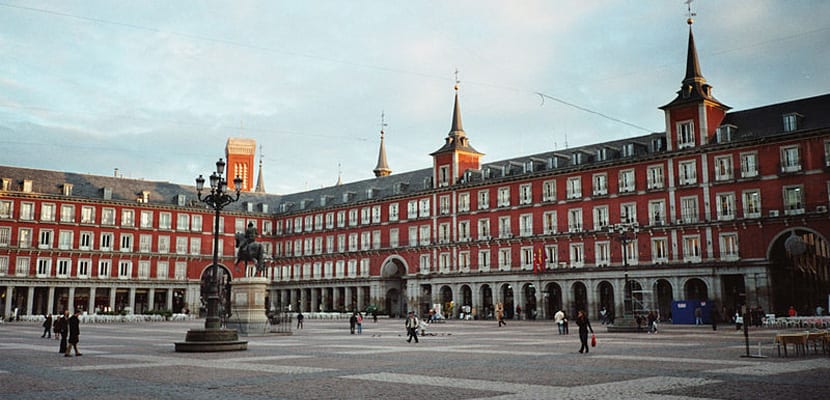
Madrid is the capital of Spain, the largest city in the country and the second in the European Union with a population of more than 3 million inhabitants (more than 6 million in the metropolitan area). Since the mid-XNUMXth century, in the time of King Felipe II, it has been the capital of Spain and the seat of the Government, the Cortes, and is also the official residence of the kings. Also, Madrid offers innumerable places to know and places to get lost.
Either for a brief getaway or for a business trip, if you plan to visit Madrid soon, here are the emblematic places to see in Madrid.
Plaza Mayor
In its origins it was a square located on the outskirts of the walled city. It was known as Plaza del Arrabal and merchants even came to sell their products at a cheaper price, which is why it was always a place very frequented by the locals.
Towards the middle of the XNUMXth century, it was granted the privilege of holding a monthly fair and over time it acquired a more urban aspect when some houses were built around it. When, at the end of that same century, Felipe II moved the court to Madrid, it was necessary to create an authentic Plaza Mayor given the popularity of this place and the relevance that the city took. The king entrusted the architect Juan de Herrera with the project, who conceived it as a rectangle 152 meters long by 94 meters wide.
Here the different existing guilds met to sell their products and for this they were distributed to all corners of the Plaza Mayor giving their name, in this way, to the Casa de la Carnicería, the Casa de la Panadería, the Arco de Cuchilleros, etc.
It took only two years and around 900.000 ducats to build it, but its construction marked an architectural milestone in the city, as it was the largest public space in Madrid that could be seen from anywhere in the city. In addition, it soon began to host various types of events such as popular shows, tournaments, processions and beatifications, public executions, etc.
For almost 150 years, at Christmas the Plaza Mayor has been filled with stalls with Christmas items, joke objects and costumes of all kinds. And recently it celebrated its 400th anniversary in style.
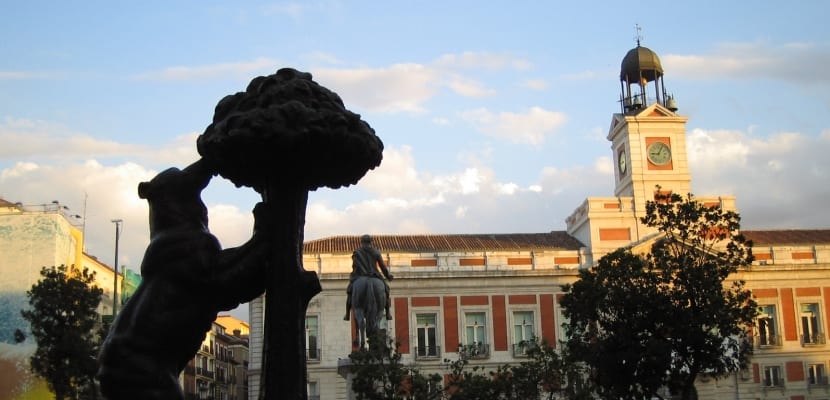
Puerta del Sol
Near the Plaza Mayor is Puerta del Sol, one of the most famous squares in Madrid. Its construction took place in several stages: in the middle of the XNUMXth century, the Casa de Correos began to be built and a century later, the square took its final shape thanks to the architects Lucio del Valle, Juan Rivera and José Morer. It was not until the XNUMXth century when the fountain, the gardens were added and the pedestrian zone was increased.
In Puerta del Sol we find three very famous places: the statue of the bear and the strawberry tree (1967), a meeting point for locals, the clock and the post office from where the end of the year chimes are emitted and kilometer zero, point where the Spanish radial highways begin and where the tourists take the pertinent photograph.
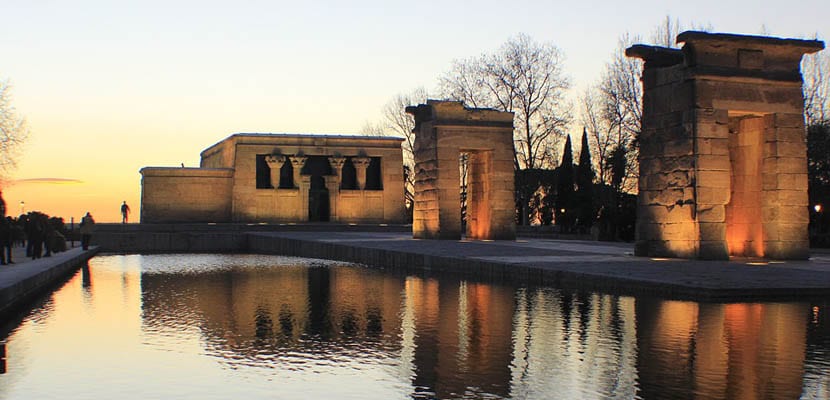
Temple of Debod
In the Parque de la Montaña de Madrid is located one of the most beloved great treasures of the capital of Spain: the temple of Debod. A 2.200-year-old temple that has become a symbol of the city.
Located to the west of the Plaza de España, this ancient monument was a gift from Egypt to Spain for its collaboration in the rescue of the Nubian temples on the occasion of the construction of the great Aswan Dam. In this way it was transported stone by stone and opened to the public in 1972 after two years of reconstruction. It was a difficult process since, in addition to not having plans, some original stones were lost during the dismantling and transportation.
The reconstruction that was carried out in Madrid maintained the orientation from east to west of its original place. The temple is surrounded by gardens and there are many people who take advantage of the place to walk, have a picnic, play sports or sunbathe on the lawn. As a curiosity, the lake that we find around the temple is a memory of the Nile.
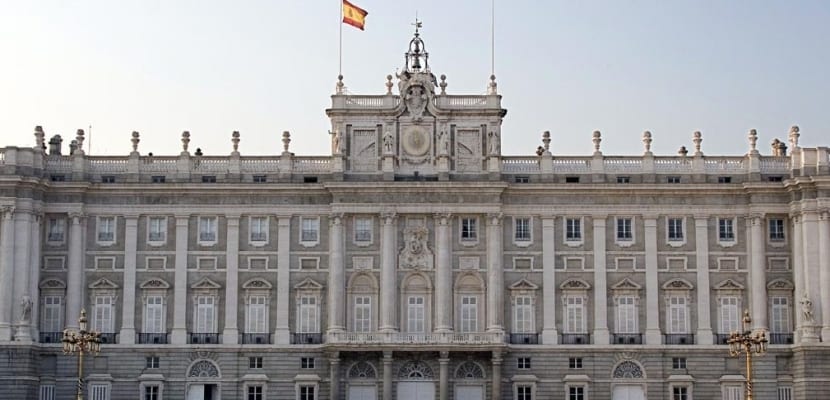
Facade of the Royal Palace of Madrid
Royal Palace
The Royal Palace of Madrid, also known as the Palacio de Oriente, was the official residence of the kings of Spain although today it is used exclusively for receptions and official acts since the monarchs reside in the Palacio de la Zarzuela.
The construction of the Royal Palace began in 1738 and its location is the same as that of the Palace of the Habsburgs, destroyed on Christmas Eve 1734 by fire. It is surrounded by the Campo del Moro gardens, dating from the Middle Ages, and by the Sabatini gardens, which were created in the XNUMXth century. Campo del Moro can be visited during the day.
It is very interesting to contemplate the changing of the guard of the Royal Palace, which takes place every Wednesday from October to July at 11 in the morning.
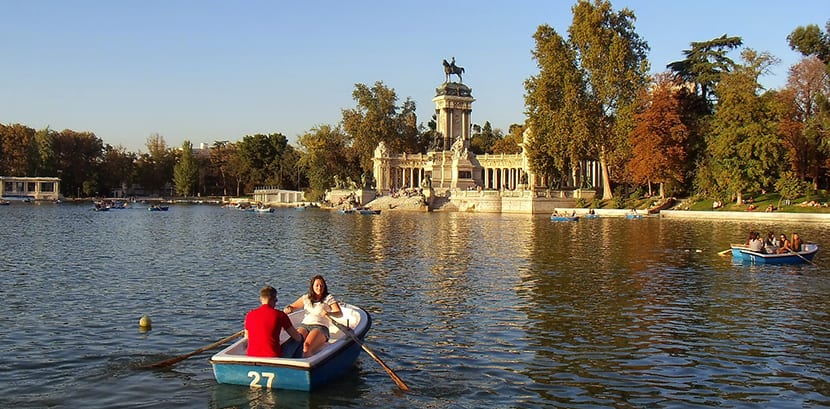
Parque del Retiro
With 125 hectares and more than 15.000 trees, El Retiro Park is a haven of peace in the heart of Madrid. Not only is it one of the lungs of the capital of Spain, but it also offers locals and visitors a wide range of culture, leisure and sports.
The origins of the El Retiro park are in the seventeenth century when the valid King Felipe IV, the Count-Duke of Olivares, gave the monarch some land for the enjoyment of the royal family. Since then it has undergone numerous modifications for different reasons.
If you have ever been to Madrid you have probably gone to El Retiro park to walk, have a drink on its charming terraces and take some photos. However, despite its popularity, very few know the secrets of this busy urban oasis and symbol of the city.